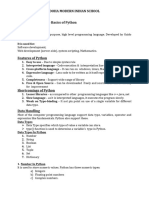0 ratings0% found this document useful (0 votes)
4 viewsIntroduction to Python
Uploaded by
aryamhatre2013Copyright
© © All Rights Reserved
We take content rights seriously. If you suspect this is your content, claim it here.
Available Formats
Download as DOCX, PDF, TXT or read online on Scribd
0 ratings0% found this document useful (0 votes)
4 viewsIntroduction to Python
Uploaded by
aryamhatre2013Copyright
© © All Rights Reserved
We take content rights seriously. If you suspect this is your content, claim it here.
Available Formats
Download as DOCX, PDF, TXT or read online on Scribd
You are on page 1/ 3
Introduction to Python
Python is a high-level, interpreted programming language widely used for developing
software, web applications, data analysis, machine learning, and more. It is beginner-friendly
because of its simple and readable syntax.
Key Features of Python:
1. Easy to Learn: Simple syntax similar to English.
2. Interpreted Language: Executes code line by line, making debugging easy.
3. Versatile: Can be used for web development, data science, AI, etc.
4. Cross-platform: Runs on Windows, Mac, Linux, etc.
5. Open Source: Free to use and distribute.
Operators in Python
Python has several types of operators used to perform operations on variables and values:
1. Arithmetic Operators
Perform mathematical operations.
Examples:
o + (Addition): a + b
o - (Subtraction): a - b
o * (Multiplication): a * b
o / (Division): a / b
o % (Modulus): a % b
2. Comparison (Relational) Operators
Compare two values.
Examples:
o == (Equal to): a == b
o != (Not equal to): a != b
o > (Greater than): a > b
o < (Less than): a < b
o =< or >=
3. Logical Operators
Combine multiple conditions.
Examples:
o and: Returns True if both conditions are true.
o or: Returns True if at least one condition is true.
o not: Reverses the boolean value.
4. Assignment Operators
Assign values to variables.
Examples:
o =: a = 5
o +=: a += 5 (Same as a = a + 5)
o *=: a *= 5
o 5+5=10
o a=10
5. Bitwise Operators
Perform operations at the bit level.
Examples:
o & (AND), | (OR), ^ (XOR).
6. Membership Operators
Test if a value is in a sequence.
Examples:
o in: 6 in [1, 2, 3, 4, 5] → True
o not in: 6 not in [1, 2, 3, 4, 5] → True
7. Identity Operators
Compare the memory location of objects.
Examples:
o is: a is b
o is not: a is not b
Python Tools and Libraries
1. Tools for Writing Python Code
IDLE: Built-in Python IDE.
PyCharm: A powerful IDE for Python.
Jupyter Notebook: Popular for data science and machine learning.
VS Code: Lightweight editor with Python extensions.
2. Common Python Libraries
NumPy: For numerical calculations.
Pandas: For data manipulation and analysis.
Matplotlib: For creating graphs and charts.
TensorFlow: For machine learning.
Simple Python Example
python
Copy code
# Arithmetic Operators Example
a = 10
b=5
print("Addition:", a + b); # Output: 15
print("Multiplication:", a * b) # Output: 50
# Logical Operator Example
x = True
y = False
print("x and y:", x and y) # Output: False
print("x or y:", x or y) # Output: True
Let me know if you need help creating
questions or additional examples
You might also like
- Class IX Robotics(Introduction to Data - Programming with Python) Lesson 3 Introduction to Operators Session 2024--25No ratings yetClass IX Robotics(Introduction to Data - Programming with Python) Lesson 3 Introduction to Operators Session 2024--254 pages
- Learn Python Quickly and Python Coding Exercises Coding For Beginners B08RDY478FNo ratings yetLearn Python Quickly and Python Coding Exercises Coding For Beginners B08RDY478F124 pages
- Python - 10 Marks Sol. of Previous PUT_Bharat_AggNo ratings yetPython - 10 Marks Sol. of Previous PUT_Bharat_Agg43 pages
- J910-YT01-P0SAA-145860 HVAC Electrical Equipment Datasheet (Power - Control Cables, Cable Trays, Conduit, Etc) Rev. 1 (AFC)No ratings yetJ910-YT01-P0SAA-145860 HVAC Electrical Equipment Datasheet (Power - Control Cables, Cable Trays, Conduit, Etc) Rev. 1 (AFC)54 pages
- Cult Ritual Killings in Ancient Rome - Winter WatchNo ratings yetCult Ritual Killings in Ancient Rome - Winter Watch3 pages
- Preliminary Examination Organization and ManagementNo ratings yetPreliminary Examination Organization and Management4 pages
- Intensive Green Roof Technical Manual - Bauder LTDNo ratings yetIntensive Green Roof Technical Manual - Bauder LTD42 pages
- State Advisory Panel & Interagency Coordinating Council: Involvement in OSEP's SPP/APR ProcessNo ratings yetState Advisory Panel & Interagency Coordinating Council: Involvement in OSEP's SPP/APR Process23 pages
- Jnana Yoga and Ramanuja's SharaNagati Gadyam100% (1)Jnana Yoga and Ramanuja's SharaNagati Gadyam25 pages
- Lesson 2 Introduction and Basic Concepts (Part 1)No ratings yetLesson 2 Introduction and Basic Concepts (Part 1)3 pages

























































































